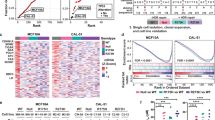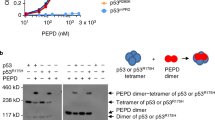Abstract
The novel candidate tumor suppressor p73, a structural and functional homolog of p53, activates various p53 responsive promoters and induces tumor cell apoptosis. Although p73 is infrequently mutated in human cancers, we have previously found two types of p73 mutation with amino acid substitution (P405R and P425L) in primary neuroblastoma and lung cancer. Here we report generations of the p73 mutants with either P405R or P425L substitution and functional analysis of these naturally occurring mutants. Indirect immunofluorescence staining revealed that nuclear accumulation of p73α or p73β was not affected by these mutations. The P425L substitution reduced the ability of p73α to transactivate various p53 responsive promoters (p21Waf1, Mdm2, and Bax). Moreover, this down-regulation was correlated with the reduced capability of p73α(P425L) to suppress cell growth in p53-deficient SAOS-2 cells. In contrast, p73β(P425L) was as effective as wild-type p73β in transactivation and growth inhibition. On the other hand, the P405R substitution had no significant effect on both the transcriptional activity and the growth-suppressive ability of p73α or p73β. These results suggested that, at least, one of the naturally occurring p73 mutants, p73α(P425L), was a functionally defective mutant of p73.
This is a preview of subscription content, access via your institution
Access options
Subscribe to this journal
Receive 50 print issues and online access
$259.00 per year
only $5.18 per issue
Buy this article
- Purchase on Springer Link
- Instant access to full article PDF
Prices may be subject to local taxes which are calculated during checkout




Similar content being viewed by others
References
Agami R, Blandino G, Oren M, Shaul Y . 1999 Nature 399: 809–813
Anderson ME, Woelker B, Reed M, Wang P, Tegtmeyer P . 1997 Mol. Cell. Biol. 17: 6255–6264
Chen C, Okayama H . 1987 Mol. Cell. Biol. 7: 2745–2752
De Laurenzi V, Costanzo A, Barcaroli D, Torrinoni A, Falclco M, Annicchiarico-Petruzzelli M, Levrero M, Melino G . 1998 J. Exp. Med. 188: 1763–1768
De Laurenzi V, Catanl MV, Teminoni A, Corazzari M, Melino G, Costanzo A, Levrero M, Knight RA . 1999 Cell Death Differ. 6: 389–390
De Laurenzi V, Raschella G, Barcaroli D, Annicchiarico-Petruzzelli M, Ranalli M, Catani MV, Tanno B, Costanzo A, Levrero M, Melino G . 2000 J. Biol. Chem. 275: 15226–15231
Dickman S . 1997 Science 277: 1605–1606
Di Como CJ, Gaiddon C, Prives C . 1999 Mol. Cell. Biol. 19: 1438–1449
Fang L, Lee SW, Aaronson SA . 1999 J. Cell Biol. 147: 823–830
Friend S . 1994 Science 265: 334–335
Gong J, Costanzo A, Yang HQ, Melino G, Kaelin Jr WG, Levrero M, Wang JYJ . 1999 Nature 399: 806–809
Hollstein M, Sidransky D, Vogelstein B, Harris CC . 1991 Science 253: 49–53
Ichimiya S, Nimura Y, Kageyama H, Takada N, Sunahara M, Shishikura T, Nakamura Y, Sakiyama S, Seki N, Ohira M, Kaneko Y, McKeon F, Caput D, Nakagawara A . 1999 Oncogene 18: 1061–1066
Ikawa S, Nakagawara A, Ikawa Y . 1999 Cell Death Differ. 6: 1154–1161
Jost CA, Marin MC, Kaelin Jr WG . 1997 Nature 389: 191–194
Kaelin Jr WG . 1999a J. Natl. Cancer Inst. 91: 599–604
Kaelin Jr WG . 1999b Oncogene 18: 7701–7705
Kaghad M, Bonnet H, Yang A, Creancier L, Biscan JC, Valent A, Minty A, Chalon P, Lelias JM, Dumont X, Ferrara P, McKeon F, Caput D . 1997 Cell 90: 809–819
Kim AL, Raffo AJ, Brandt-Rauf PW, Pincus MR, Monaco R, Abarzua P, Fine RL . 1999 J. Biol. Chem. 274: 34924–34931
Ko LJ, Prives C . 1996 Genes Dev. 10: 1054–1072
Ozaki T, Naka M, Takada N, Tada M, Sakiyama S, Nakagawara A . 1999 Cancer Res. 59: 5902–5907
Pozniak CD, Radinovic S, Yang A, McKeon F, Kaplan DR, Miller FD . 2000 Science 289: 304–306
Takada N, Ozaki T, Ichimiya S, Todo S, Nakagawara A . 1999 Cancer Res. 59: 2810–2814
Ueda Y, Hijikata M, Takagi S, Chiba T, Shimotohno K . 1999 Oncogene 18: 4993–4998
Yang A, Walker N, Bronson R, Kaghad M, Oosterwegel M, Bonnin J, Vagner C, Bonnet H, Dikkens P, Sharpe A, McKeon F, Caput D . 2000 Nature 404: 99–103
Yuan ZM, Shioya H, Ishiko T, Sun X, Gu J, Huang YY, Lu H, Kharbanda S, Weichselbaum R, Kufe D . 1999 Nature 399: 814–817
Zeng X, Chen L, Jost CA, Maya R, Keller D, Wang X, Kaelin Jr WG, Oren M, Chen J, Lu H . 1999 Mol. Cell. Biol. 19: 3257–3266
Acknowledgements
We are grateful to Dr Gerry Melino (University of Rome, Rome, Italy) for providing the mammalian expression plasmid encoding HA epitope-tagged p73α, p73β or p73γ. We thank Aiko Morohashi for her technical assistance. This work was supported in part by a Grant-in-Aid from the Ministry of Health and Welfare for a New 10-Year Strategy for Cancer Control, a Grant-in-Aid for Scientific Research on Priority Areas, and a Grant-in-Aid for Scientific Research (B) from the Ministry of Education, Science, Sports and Culture, Japan.
Author information
Authors and Affiliations
Rights and permissions
About this article
Cite this article
Naka, M., Ozaki, T., Takada, N. et al. Functional characterization of naturally occurring mutants (P405R and P425L) of p73α and p73β found in neuroblastoma and lung cancer. Oncogene 20, 3568–3572 (2001). https://doi.org/10.1038/sj.onc.1204470
Received:
Revised:
Accepted:
Published:
Issue Date:
DOI: https://doi.org/10.1038/sj.onc.1204470
Keywords
This article is cited by
-
Functions, divergence and clinical value of TAp73 isoforms in cancer
Cancer and Metastasis Reviews (2013)
-
Key role of mitochondria in cerulenin-mediated apoptosis
Cell Death & Differentiation (2002)
-
Role of p73 in malignancy: tumor suppressor or oncogene?
Cell Death & Differentiation (2002)



